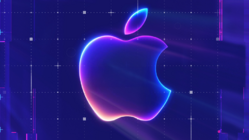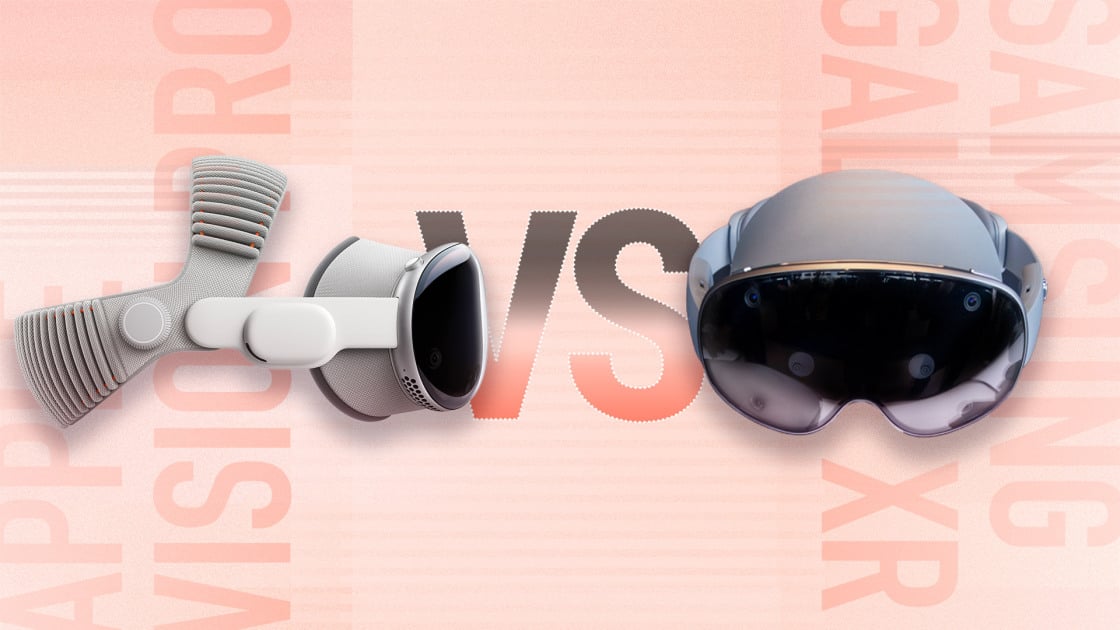Price
Samsung is known for its Apple-like premium designs and pricing, but in this case, it’s undercutting Cupertino significantly. At $1,799, the Galaxy XR is still pricey compared with almost any other VR or XR headset, but it’s just over half the price of the $3,499 Apple Vision Pro. The line between expensive and way, way too expensive isn’t set in stone, but to me, coming in under $2,000 categorizes the Galaxy XR as a pricey investment, but maybe a reasonable one considering the tech, whereas the Vision Pro costs about as much as the average monthly rent for an apartment in New York City.
Winner: Galaxy XR (by about half)
Design
One of my biggest complaints about the Vision Pro (aside from the price) is how it feels to wear. The aluminum and glass visor looks incredibly sleek, but its 26.4- to 28.2-ounce (1.65- to 1.76-pound) heft is a lot to carry on the head, especially because its original Dual Loop and Solo Knit straps leave it feeling very front-heavy. The M5 Vision Pro features a new Dual Knit loop that may distribute the weight more evenly, but I haven’t tried it yet, and the headset itself still weighs around a pound and a half.
The Samsung Galaxy XR strap (Credit: Joseph Maldonado)
The Galaxy XR, meanwhile, weighs just 19.2 ounces (1.2 pounds) while still offering a premium-feeling metal and glass construction, and its head strap is a much more robust harness that cups the back of the head and can easily be adjusted. I only used it for about half an hour, but it felt more secure and less bulky than the Vision Pro on my face.
Winner: Galaxy XR (but the Vision Pro’s new headstrap might even things out)
Display
The Samsung Galaxy XR’s display (Credit: Joseph Maldonado)
Both devices’ micro-LED projectors are sharper by far than those of every other mixed reality headset on the market, but the Galaxy XR outperforms the Vision Pro in total pixel count, with 29 million to 23 million. While Apple doesn’t disclose per-eye resolution, the Galaxy XR beams a 3,552-by-3,840 picture, or 13.6 million pixels into each eye. The Vision Pro has a higher maximum refresh rate of 120Hz compared with the Galaxy XR’s 100Hz, but I think having a clearer picture is more important.
Winner: Galaxy XR (with the most pixels)
Software Platform
This is where the Galaxy XR gets really interesting, because unlike the visionOS-powered Vision Pro, it isn’t designed to be the sole part of a development ecosystem. It’s the first device built on Google’s Android XR operating system, an open mixed reality platform not married to a single brand. That means software made for the Galaxy XR should be easily ported to other Android XR headsets and even future smart glasses.
Think about it like smartphones. Samsung is one of the biggest names in Android phones, but it isn’t the only one. Asus, Google, Motorola, OnePlus—many companies make Android phones, and just as many could make Android XR devices. Meanwhile, just as Apple is the only company that ever makes iPhones, it’s the only company that ever makes Vision Pros.
An Android XR interface mockup (Credit: Google)
As for the nuts and bolts of Android XR and visionOS, both have very similar interfaces, and can run both purpose-built mixed reality experiences and many standard mobile apps (Android on Android XR, iPadOS on visionOS). The app libraries for both will probably be similar at first, but we’ll have to see how developers proceed.
On the AI front, because Google created Android XR, Gemini is built into the platform and is at your beck and call on the Galaxy XR. Apple’s suite of AI features is available on the Vision Pro, so you can access similar search, analysis, and generation functions, but the same can’t be said about the voice assistant itself. While Siri is available on the Vision Pro, it lacks the conversational experience that Gemini offers on the Galaxy XR, and it’s unclear when Apple’s voice assistant will become similarly personable.
Winner: Galaxy XR (the first step for Android XR as an ecosystem, and the AI assistant is easier to talk to)
Get Our Best Stories!
Love All Things Apple?

Sign up for our Weekly Apple Brief for the latest news, reviews, tips, and more delivered right to your inbox.
Sign up for our Weekly Apple Brief for the latest news, reviews, tips, and more delivered right to your inbox.
By clicking Sign Me Up, you confirm you are 16+ and agree to our Terms of Use and Privacy Policy.
Thanks for signing up!
Your subscription has been confirmed. Keep an eye on your inbox!
Controls
Pinching to select in visionOS on the Apple Vision Pro (Credit: Will Greenwald)
I’ve described the Apple Vision Pro as by far the most advanced mixed reality device I’ve ever used, and that’s mostly because of its control system. Instead of controllers, it uses inward-facing cameras to track eye movements and outward-facing cameras to track hand movements, allowing you to interact with anything simply by looking at it and pinching your fingers. I hadn’t seen any headset as easy to use until the Galaxy XR.
Me pointing to navigate in the Galaxy XR (Credit: Joseph Maldonado)
Samsung also uses eye-tracking and hand-tracking cameras in its headset, which are just as capable of detecting where you’re looking and where you’re pointing as the Vision Pro. Eye-based controls will be available, but I couldn’t try them out during the short demo I had, which focused on hand gestures only. Pointing at objects felt just as intuitive as looking at them, and interacting with pinches and taps felt almost identical on both headsets, so even without confirming the eye-based controls work as well on the Galaxy XR as they do on the Vision Pro, I can say that it offers just as smooth and immersive an experience.
The Galaxy XR motion controllers (Credit: Joseph Maldonado)
Samsung will also offer conventional motion controllers, such as the ones included with Meta Quest headsets. It’s an option that the Vision Pro lacks, but it’s unclear what games and apps will utilize it instead of the very accurate hand tracking. Both headsets can also be paired with Bluetooth keyboards and game controllers for more traditional input methods.
Winner: Tie
Power
Mixed reality has different processing requirements than computers, phones, and tablets. Both headsets’ chips have dedicated co-processors that handle these functions, and they seem to do their jobs very well. For anything that doesn’t involve space and movement, like 2D apps that run in virtual windows floating in front of you, the CPU matters much more.
Recommended by Our Editors
The new M5 Apple Vision Pro, with Dual Knit strap (Credit: Apple)
In terms of raw power, Apple has the advantage, and arguably did even before it upgraded the Vision Pro’s M2 chip to the M5. Both the M2 and M5 are laptop-worthy processors and have been used in both MacBooks and iPads, paired with a separate R1 spatial processor for mixed reality functions, such as motion tracking and scanning your surroundings. The Qualcomm Snapdragon XR2+ Gen 2, which powers the Galaxy XR, is essentially a mobile chipset optimized for mixed reality and is an upgraded version of the Snapdragon XR2 Gen 2 used in the Meta Quest 3 ($500) and 3S ($300) headsets. It’s also over a year old, while Apple announced the M5 about a week ago.
Without getting too deep into the weeds, the M2 and M5 are significantly more powerful chips than the Snapdragon XR2+ Gen 2 in terms of raw processing power. While we don’t benchmark mixed reality headsets, the M2 already outperformed the Snapdragon 8 Gen 2 (the closest analog to the XR2+ Gen 2 we’ve benchmarked on phones and tablets), and the M5 on the 2025 iPad Pro is a massive boost beyond that. I didn’t notice any sluggishness when I tried out Samsung’s headset, but at least on paper, the Vision Pro is definitely packing more under the hood.
Winner: Vision Pro (M2 or M5, it’s a faster chip either way)
Battery Life
The Apple Vision Pro with battery pack (Credit: Joseph Maldonado)
This is a common weakness for both devices, but it’s a general issue for all standalone mixed reality headsets. Samsung estimates the Galaxy XR can last up to two hours on a charge with general use and 2.5 hours just playing videos, which is the same as the M2 Vision Pro. Apple claims the M5 Vision Pro can last slightly longer, offering up to 2.5 hours of general use and three hours of video playback.
Winner: Vision Pro (M5, specifically)
Which Is the Better Headset?
I can’t name a winner until I spend more time with the Galaxy XR outside of a controlled demo environment, and test the M5 Vision Pro to see if it feels more comfortable and performs noticeably better than its M2 sibling. The Vision Pro seems to have the edge in power, but the Galaxy XR has some notable advantages in almost every other way, and it’s far less expensive. Check back soon for my full reviews of the Galaxy XR and the M5 Vision Pro, and a definitive verdict on which one is better.
In the meantime, you can always get into XR and VR on the comparative cheap with other VR headsets, and if you’re interested in seeing another direction wearable displays are heading in, take a look at our list of the best smart glasses.












